Study on Heat Transfer Performance of Antifreeze-R134a Heat Exchanger (ARHEx)
Abstract
:1. Introduction
2. Helicopter Thermal Management of Avionics Based on ARHEx
2.1. Helicopter Thermal Management System
2.2. Structural Parameters of ARHEx
3. Experimental Prototype and Experimental Conditions
3.1. Experimental Prototype
- , kg/s, marked with 5, mass flow rate of refrigerant;
- , °C, marked with T1, inlet temperature of EEV;
- , kPa, marked with P1, inlet pressure of EEV;
- , °C, marked with T2, refrigerant outlet temperature of ARHEx;
- , kPa, marked with P2, refrigerant outlet pressure of ARHEx;
- ΔP, kPa, marked with P0, refrigerant pressure drop of AREHx;
- , L/min, marked with 8, volume flow rate of antifreeze;
- , °C, marked with T4, antifreeze inlet temperature of ARHEx;
- , kPa, marked with P4, antifreeze inlet pressure of ARHEx;
- , °C, marked with T3, antifreeze outlet temperature of ARHEx;
- , kPa, marked with P3, antifreeze outlet pressure of ARHEx.
3.2. Experimental Conditions
3.3. Experimental Stability
4. Experimental Result Analysis
4.1. Heat Transfer Quantity
4.2. Efficiency of Heat Transfer
- (1)
- With the increase of , η0 decreases gradually. For = 338 kPa and = 362 kPa under the same volume flow rate, η0 does not necessarily decrease with the increase of . However, for = 388 kPa and = 415 kPa under the same volume flow rate, η0 decreases with the increase of .
- (2)
- η0 increases gradually with the increase of . For all experimental results, when = 415 kPa, = 20 °C and = 20 L/min, η0 reaches its maximum value and is 86%. When = 338 kPa, = 40 °C and = 60 L/min, η0 reaches its minimum value and is 16%.
4.3. Heat Transfer Formula for Antifreeze
4.4. Heat Transfer and Pressure Drop Formula for Refrigerant
5. Conclusions
- (1)
- The heat transfer quantity, QA, in the ground experiment can reach 15 kW;
- (2)
- The heat transfer efficiency, η0, in the ground experiment can reach 40–80%;
- (3)
- The heat transfer formula of the antifreeze side can be deduced as Nu = 0.5·Re1.396·Pr0.4;
- (4)
- The heat transfer gain factor of the refrigerant side, keva,R, is 8, and the pressure drop gain factor of refrigerant side, kdp, is 1.
Author Contributions
Funding
Conflicts of Interest
Nomenclature
| FinP | spacing of the fin |
| FinL | length of the fin |
| FinT | length of the fin |
| FinH | height of the fin |
| FinO | offset of the fin |
| t | temperature (°C) |
| p | pressure (kPa) |
| ΔP | refrigerant pressure drop (kPa) |
| volume flow rate (L/min) | |
| mass flow rate (kg/s) | |
| SH | superheat (°C) |
| H | specific enthalpy (kJ/kg) |
| Q | heat transfer quantity (kW) |
| Cp | specific heat (J/kg/K) |
| v | velocity (m/s) |
| h | heat transfer coefficient (W/m2/K) |
| Greek symbols | |
| ρ | density (kg/m3) |
| Δ | unsteadiness (%) |
| η | heat transfer efficiency |
| λ | thermal conductivity (W/m/K) |
| μ | dynamic viscosity (Pa·s) |
| ξ | friction factor coefficient |
| ε | absolute roughness (mm) |
| Subscripts | |
| eva | evaporator |
| c | cold side of the ARHEx |
| h | hot side of the ARHEx |
| A | antifreeze |
| R | refrigerant |
| EEV | electronic expansion valve |
| eva | evaporator |
References
- Sprouse, J. F22 Environmental Control/Thermal Management Fluid Transport Optimization. SAE Tech. Paper 2000, 109, 359–364. [Google Scholar]
- Pang, L.P.; Dang, X.M. Study on Heat Transfer Performance of Skin Heat Exchanger. Exp. Heat Transf. 2015, 28, 317–327. [Google Scholar]
- Pang, L.P.; Xu, J.; Fang, L.; Gong, M.G.; Zhang, H.; Zhang, Y. Evaluation of an Improved Air Distribution System For Aircraft Cabin. Build. Environ. 2013, 59, 145–152. [Google Scholar]
- Gao, F.; Yuan, X.G. Fuel Thermal Management System of High Performance Fighter Aircraft. J. Beijing Univ. Aeronaut. Astronaut. 2009, 35, 1353–1357. [Google Scholar]
- McAdams, W.H.; Woods, W.K.; Bryan, R.L. Vaporization inside horizontal tubes-II-Benzene-oil mixtures. Trans. ASME 1942, 64, 193. [Google Scholar]
- Emo, S.; Ervin, J.; Michalak, T.E.; Tsao, V. Cycle-based vapor cycle system control and active charge management for dynamic airborne applications. SAE Tech. Paper 2014. [Google Scholar] [CrossRef]
- Tunc, I.; Mehmet, A. Light weight high performance thermal management with advanced heat sinks and extended surfaces. IEEE Trans. Compon. Packag. Technol. 2010, 33, 161–166. [Google Scholar]
- Zhao, M.; Pang, L.; Liu, M.; Yu, S. Control strategy for helicopter thermal management system based on liquid cooling and vapor compression refrigeration. Energies 2020, 13, 2177. [Google Scholar]
- Selvaraju, A.; Mani, A. Experimental investigation on R134a vapor injector refrigeration system. Int. J. Refrig. 2006, 29, 1160–1166. [Google Scholar]
- Juan, C.; Fernando, L.; Tiejun, Z. Vapor compression refrigeration cycle for electronics cooling. Int. J. Heat Mass Transf. 2013, 66, 922–929. [Google Scholar]
- Yang, S.M.; Tao, W.Q. Heat Transfer; Higher Education Press: Beijing, China, 2006. (In Chinese) [Google Scholar]
- Genić, S.B.; Jaćimović, B.M.; Janjić, B. Experimental research of highly viscous fluid cooling in cross-flow to a tube bundle. Int. J. Heat Mass Transf. 2007, 50, 1288–1294. [Google Scholar]
- Genic, S.; Jaćimović, B.M.; Janjić, B. A computational analysis of a methanol steam reformer using phase change heat transfer. Energies 2020, 13, 4324. [Google Scholar]
- Genić, S.B.; Jaćimović, B.M.; Vladić, L.A. Heat transfer rate of direct-contact condensation on baffle trays. Int. J. Heat Mass Transf. 2008, 51, 5772–5776. [Google Scholar]
- Genić, S.; Jaćimović, B.; Jarić, M.; Budimir, N.; Dobrnjac, M. Research on the shell–side thermal performances of heat exchangers with helical tube coils. Int. J. Heat Mass Transf. 2012, 55, 4295–4300. [Google Scholar]
- Genic, S.; Jaćimović, B.M.; Vladić, L.A. Air side heat transfer coefficient in plate finned tube heat exchangers. Exp. Heat Transf. 2020, 33, 388–399. [Google Scholar]
- Genic, S.; Jaćimović, B.M.; Milovančević, U.M.; Ivošević, M.M.; Otović, M.M.; Antić, M.I. Thermal performances of a black box” heat exchanger in district heating system. Heat Mass Transf. 2018, 54, 867–873. [Google Scholar]
- Maithani, R.; Kumar, A. Correlations development for Nusselt number and friction factor in a dimpled surface heat exchanger tube. Exp. Heat Transf. 2020, 33, 101–122. [Google Scholar]
- Zhang, C.; Wang, D.; Han, Y.; Zhu, Y.; Peng, X. Experimental and numerical investigation on the exergy and entransy performance of a novel plate heat exchanger. Exp. Heat Transf. 2017, 30, 162–177. [Google Scholar]
- Gorgy, E.; Eckels, S. Convective boiling of R-134a on enhanced-tube bundles. Int. J. Refrig. 2016, 68, 145–160. [Google Scholar]
- Dossat, R.J.; Horan, T.J. Principles of Refrigeration; Prentice Hall: Upper New Jersey River, NJ, USA, 2002. [Google Scholar]
- Gnielinski, V. New equations for heat and mass transfer in turbulent pipe and channel flow. Int. Chem. Eng. 1976, 16, 359–368. [Google Scholar]
- Churchill, S.W. Friction-factor equation spans all fluid flow regimes. Chem. Eng. 1977, 84, 91–92. [Google Scholar]
- Dukler, A.E.; Wicks, M.; Cleveland, R.G. Pressure drop and hold-up in two-phase flow Part A: A comparison of existing correlations Part B: An approach through similarity analysis. AIChE J. 1964, 10, 38–51. [Google Scholar]
- Jung, K.M.; Krishnan, R.A.; Kumar, G.U.; Lee, H.J. Experimental study on two-phase pressure drop and flow boiling heat transfer in a micro pin fin channel heat sink under constant heat flux. Exp. Heat Transf. 2020, 1–24. [Google Scholar] [CrossRef]
- Junqi, D.; Yi, Z.; Gengtian, L.; Weiwu, X. Experimental Study of Wavy Fin Aluminum Plate Fin Heat Exchanger. Exp. Heat Transf. 2013, 26, 384–396. [Google Scholar]
- Shibahara, M.; Liu, Q.S.; Hata, K.; Fukuda, K. Boiling heat transfer and CHF for subcooled water flowing in a narrow channel due to power transients. Exp. Heat Transf. 2020, 33, 64–80. [Google Scholar]
- Minhhung, D.; Thanhtrung, D.; Xuanvien, N. The effects of gravity on the pressure drop and heat transfer characteristics of steam in microchannels: An Experimental Study. Energies 2020, 13, 3575. [Google Scholar]
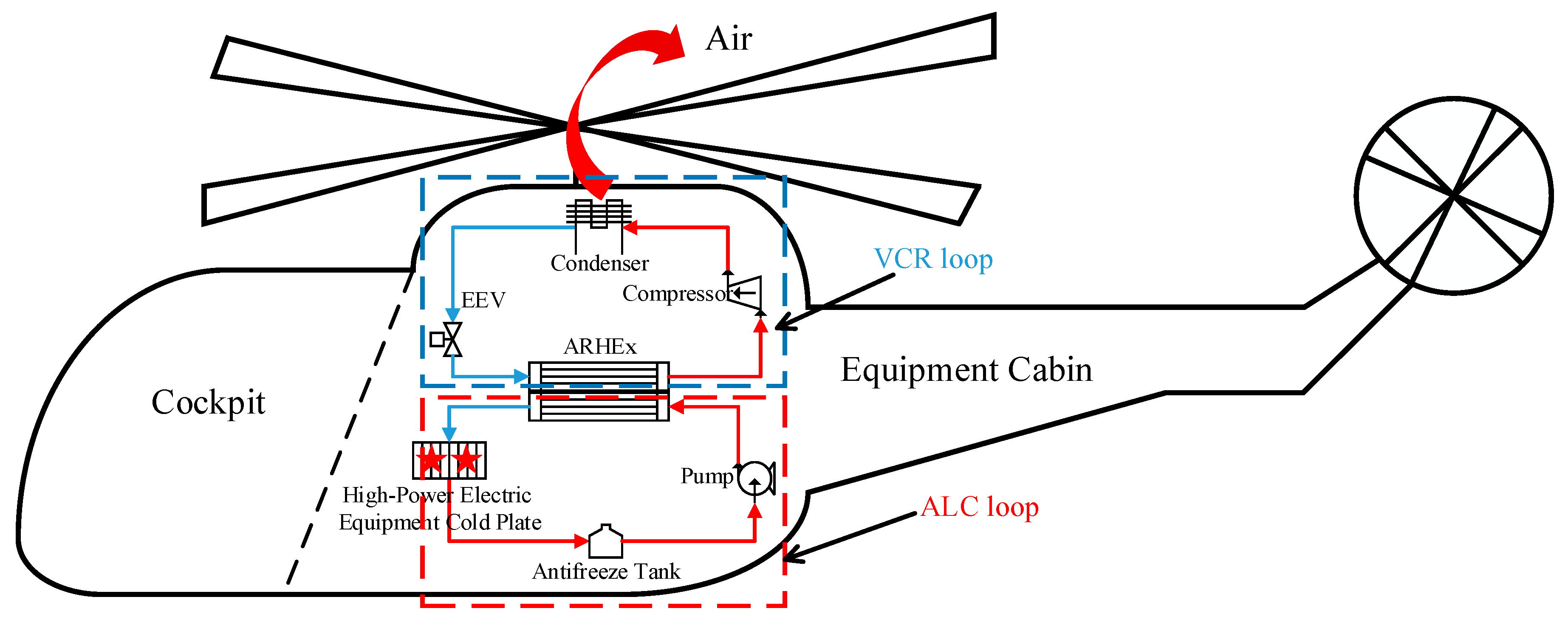
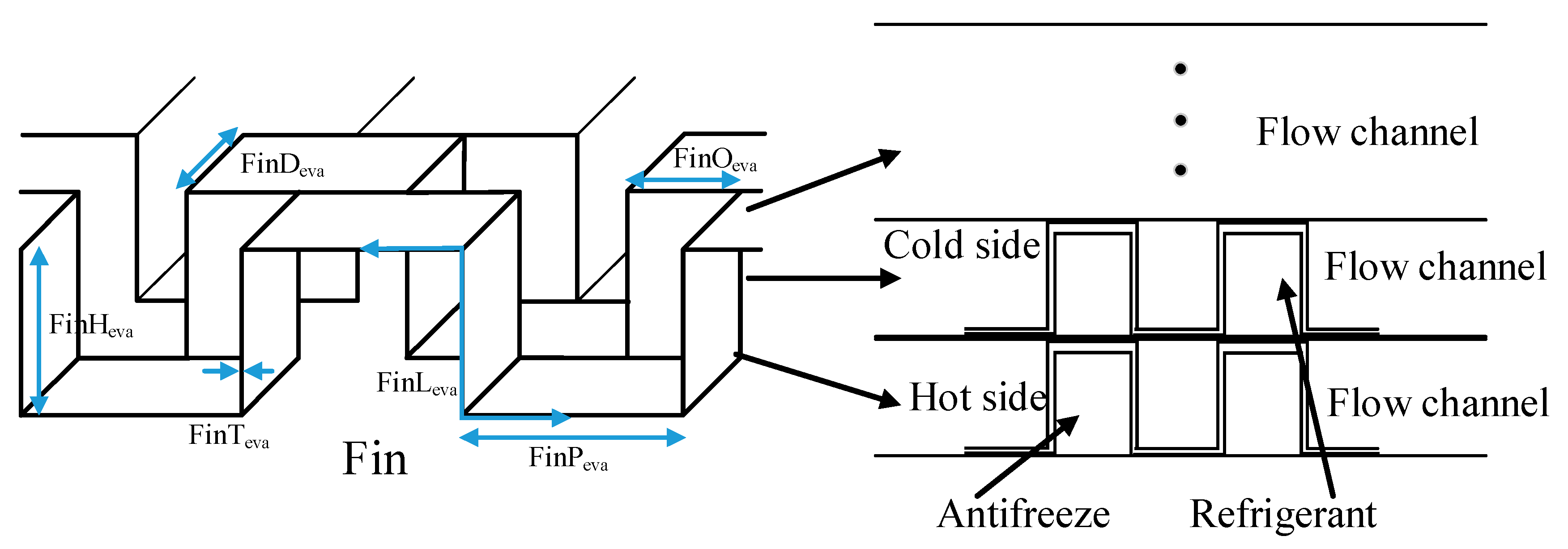

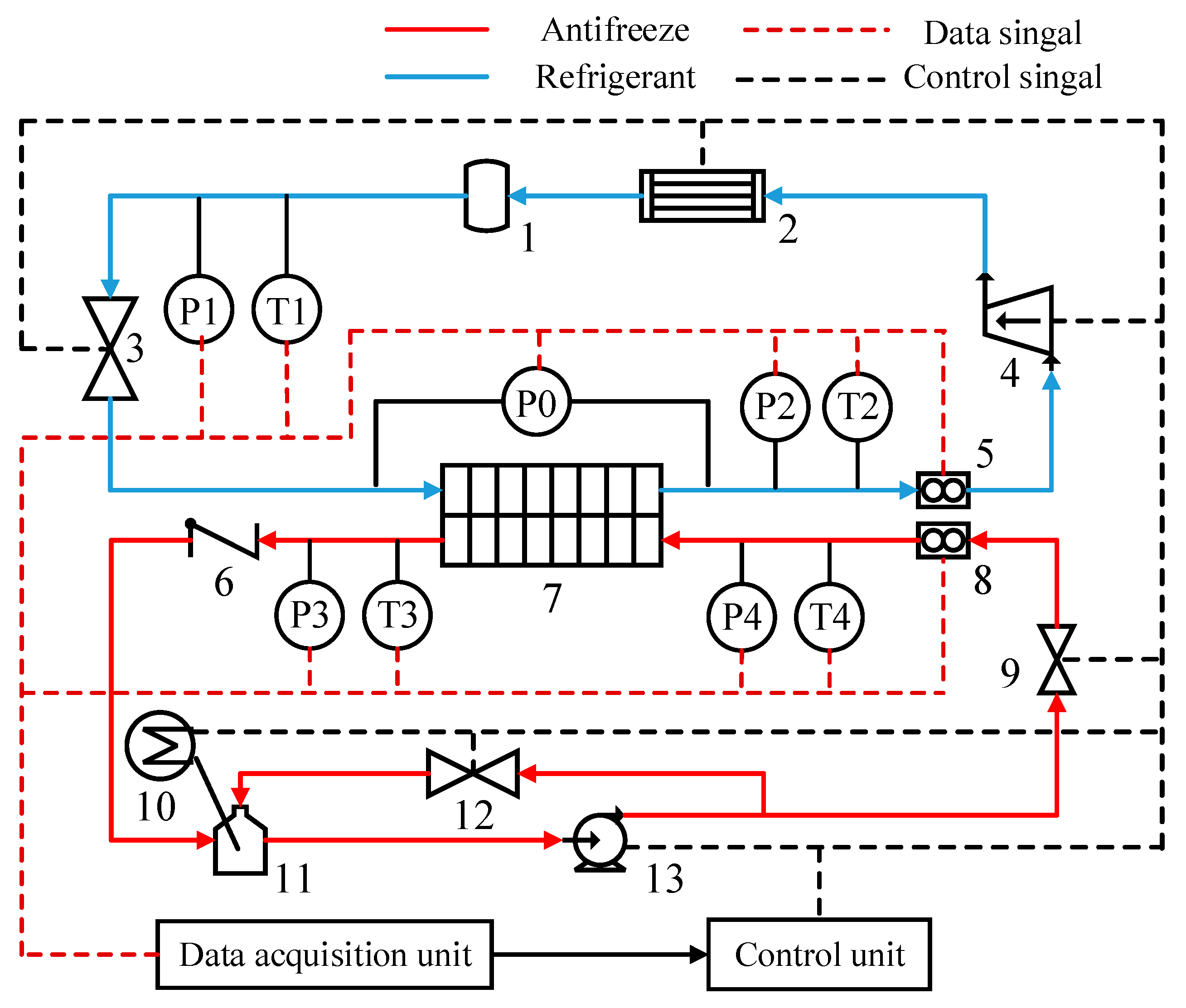
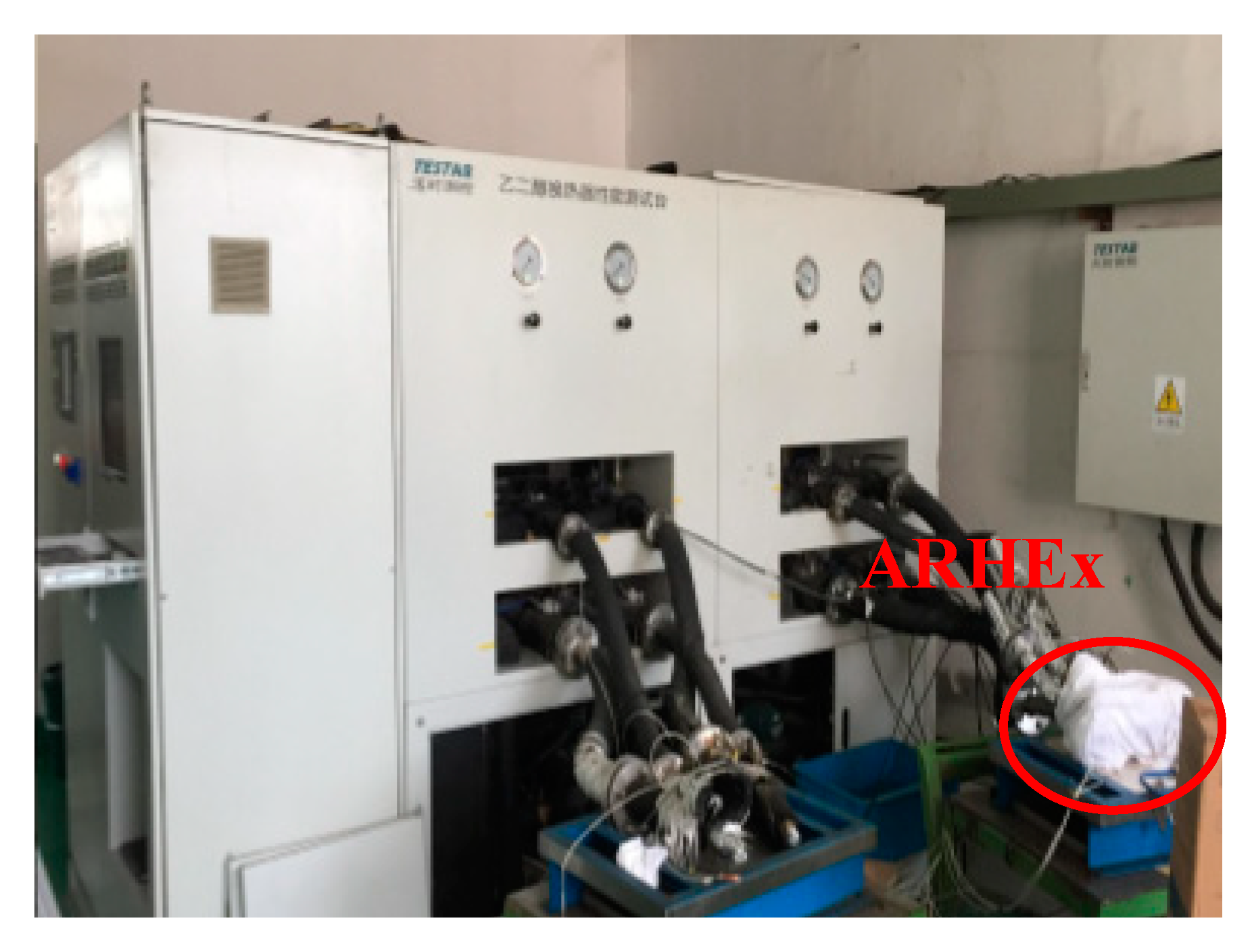
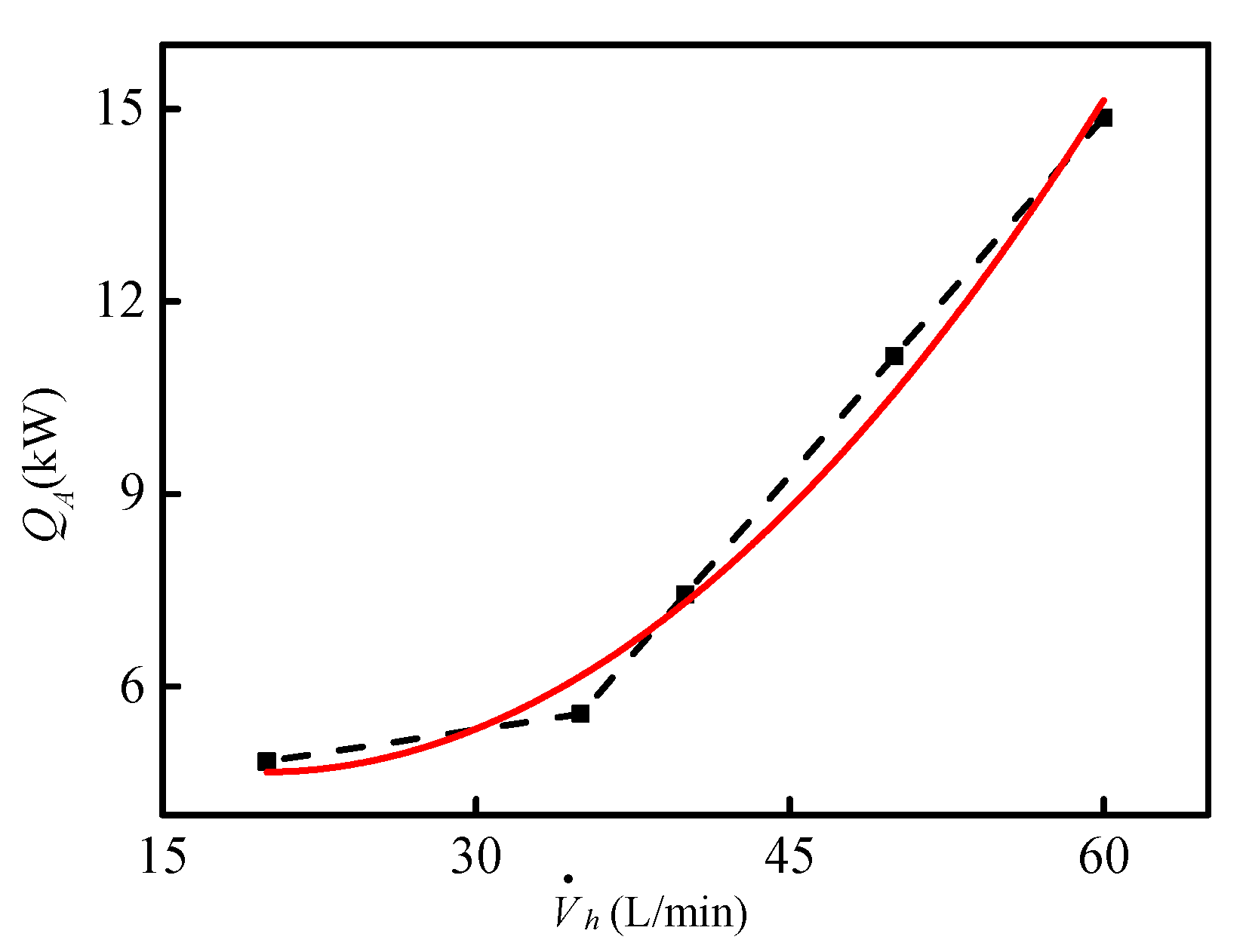

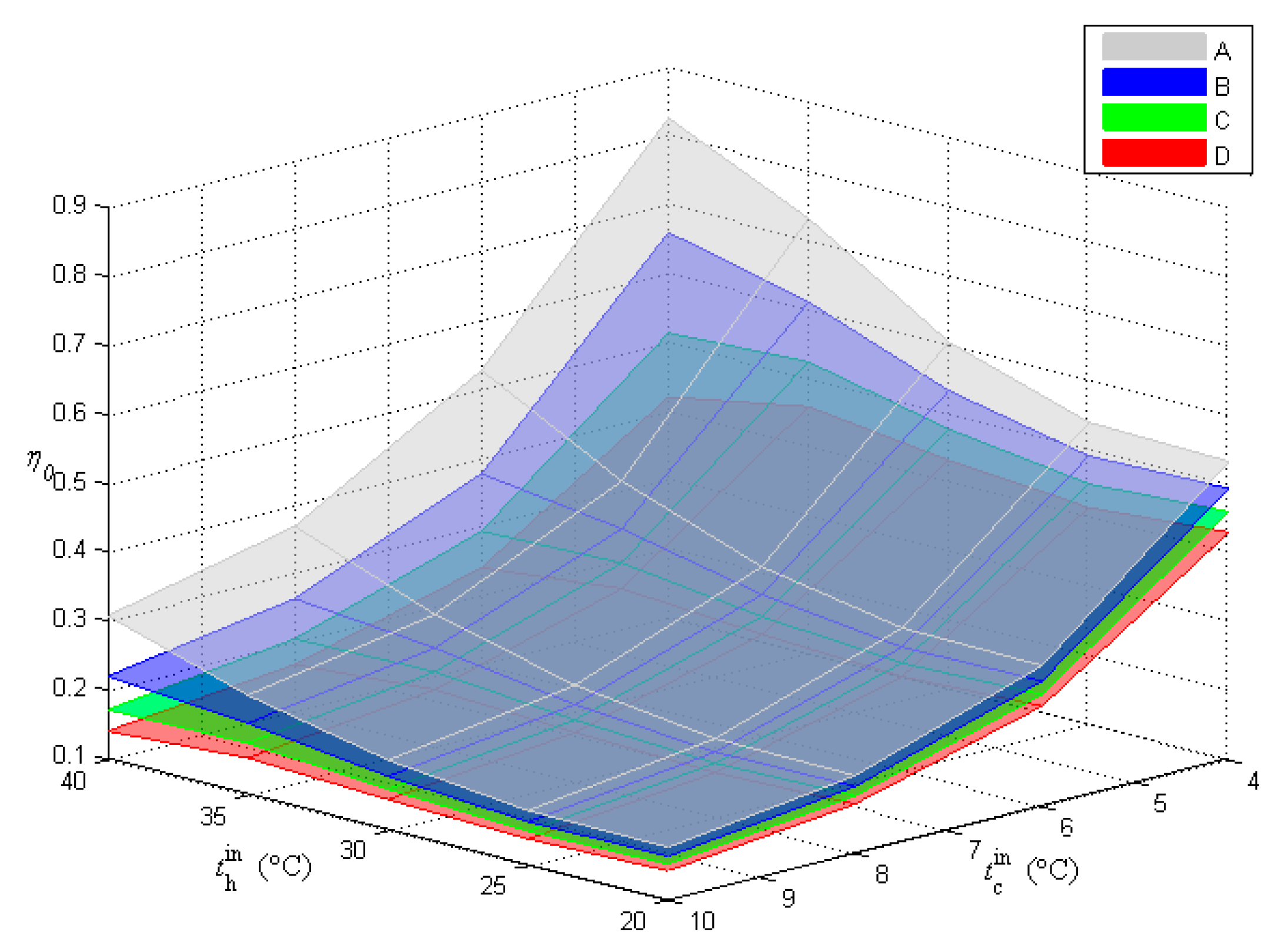

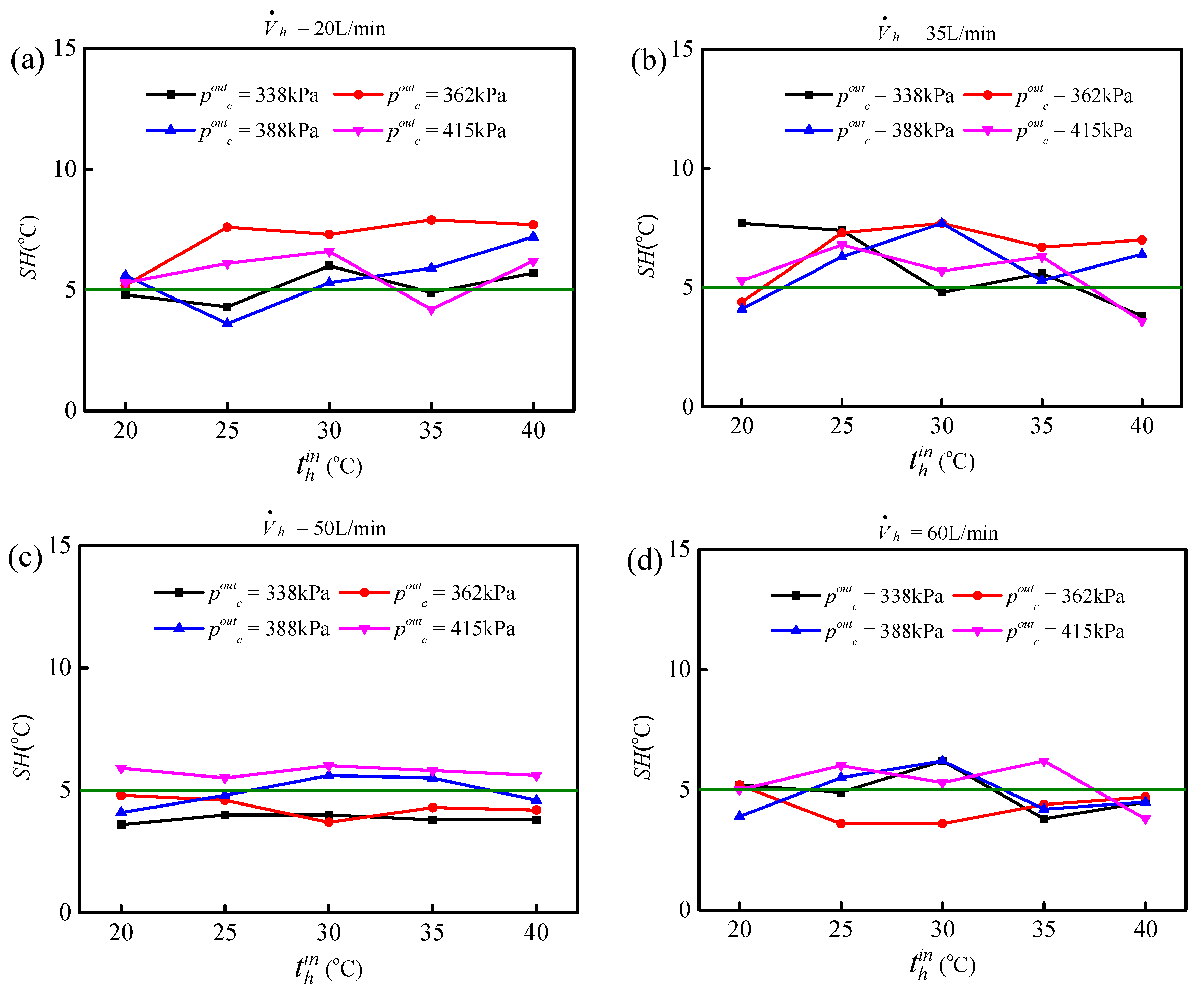
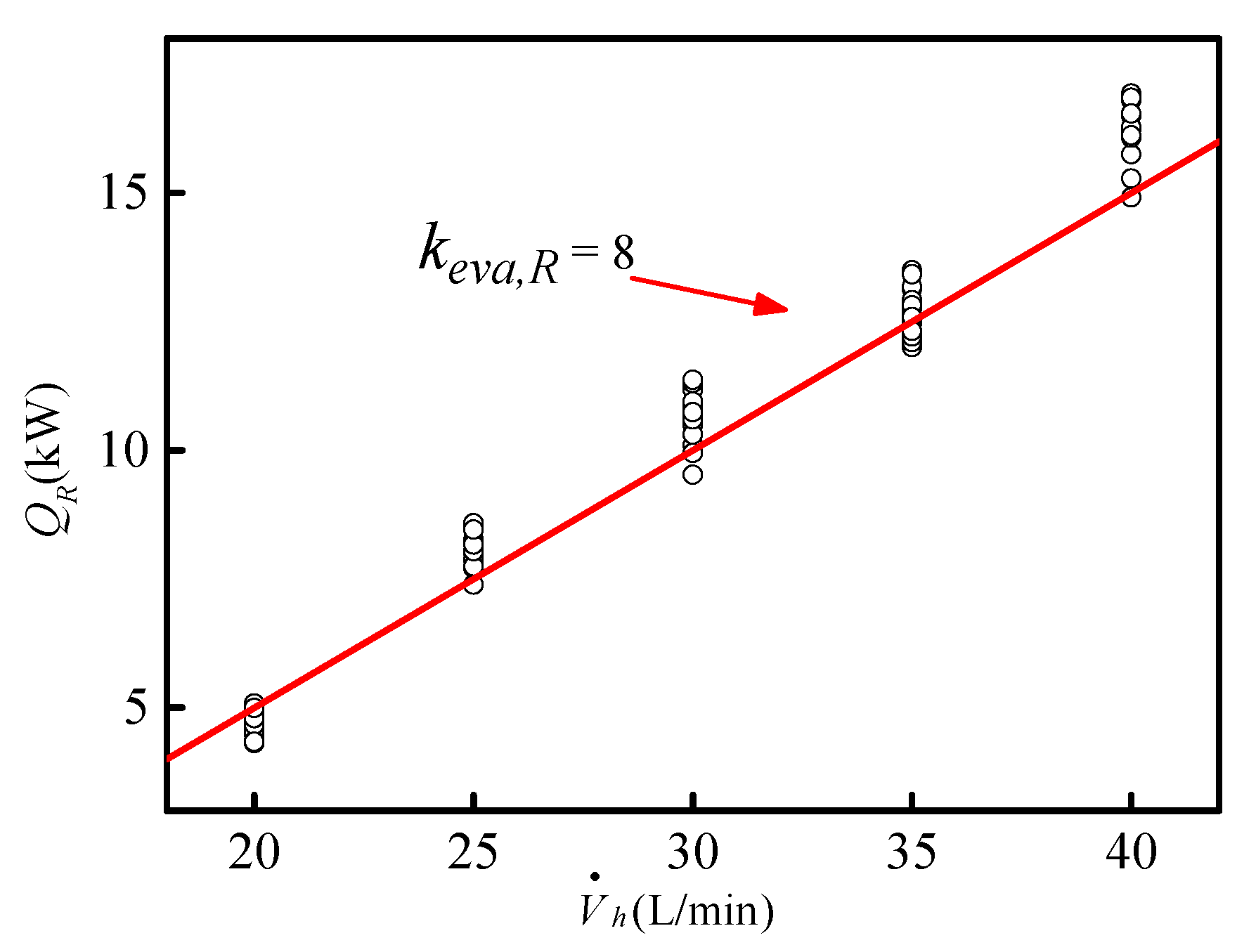
| No. | Symbol | Parameter | Value | Unit |
|---|---|---|---|---|
| 1 | Inlet temperature of EEV | 50 | °C | |
| 2 | Inlet pressure of EEV | 1492 | kPa | |
| 3 | Outlet pressure on refrigerant side | 338, 362, 388, 415 | kPa | |
| 4 | SH | Outlet superheat on refrigerant side | 5 | °C |
| 5 | Antifreeze volume flow | 20, 35, 50, 60 | L/min | |
| 6 | Inlet temperature on antifreeze side | 20, 25, 30, 35, 40 | °C | |
| 7 | Outlet pressure on antifreeze side | 100 | kPa |
Publisher’s Note: MDPI stays neutral with regard to jurisdictional claims in published maps and institutional affiliations. |
© 2020 by the authors. Licensee MDPI, Basel, Switzerland. This article is an open access article distributed under the terms and conditions of the Creative Commons Attribution (CC BY) license (http://creativecommons.org/licenses/by/4.0/).
Share and Cite
Pang, L.; Luo, K.; Yu, S.; Ma, D.; Zhao, M.; Mao, X. Study on Heat Transfer Performance of Antifreeze-R134a Heat Exchanger (ARHEx). Energies 2020, 13, 6129. https://doi.org/10.3390/en13226129
Pang L, Luo K, Yu S, Ma D, Zhao M, Mao X. Study on Heat Transfer Performance of Antifreeze-R134a Heat Exchanger (ARHEx). Energies. 2020; 13(22):6129. https://doi.org/10.3390/en13226129
Chicago/Turabian StylePang, Liping, Kun Luo, Shizhao Yu, Desheng Ma, Miao Zhao, and Xiaodong Mao. 2020. "Study on Heat Transfer Performance of Antifreeze-R134a Heat Exchanger (ARHEx)" Energies 13, no. 22: 6129. https://doi.org/10.3390/en13226129





